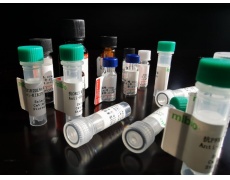中文名称:KIR3DL1抗原(重组蛋白)
英文名称: KIR3DL1 Antigen (Recombinant Protein)
别 名: KIR; NKB1; NKAT3; NKB1B; NKAT-3; CD158E1; KIR3DL1/S1
储 存: 冷冻(-20℃)
相关类别: 抗原
概 述:
|
Fusion protein corresponding to a region derived from 22-221 amino acids of human KIR3DL1 |
|
Full name: |
killer cell immunoglobulin like receptor, three Ig domains and long cytoplasmic tail 1 |
|
Synonyms: |
KIR; NKB1; NKAT3; NKB1B; NKAT-3; CD158E1; KIR3DL1/S1 |
|
Swissprot: |
P43629 |
|
Gene Accession: |
BC028206 |
|
Purity: |
>85%, as determined by Coomassie blue stained SDS-PAGE |
|
Expression system: |
Escherichia coli |
|
Tags: |
His tag C-Terminus, GST tag N-Terminus |
|
Background: |
Killer cell immunoglobulin-like receptors (KIRs) are transmembrane glycoproteins expressed by natural killer cells and subsets of T cells. The KIR genes are polymorphic and highly homologous and they are found in a cluster on chromosome 19q13.4 within the 1 Mb leukocyte receptor complex (LRC). The gene content of the KIR gene cluster varies among haplotypes, although several "framework" genes are found in all haplotypes (KIR3DL3, KIR3DP1, KIR3DL4, KIR3DL2). The KIR proteins are classified by the number of extracellular immunoglobulin domains (2D or 3D) and by whether they have a long (L) or short (S) cytoplasmic domain. KIR proteins with the long cytoplasmic domain transduce inhibitory signals upon ligand binding via an immune tyrosine-based inhibitory motif (ITIM), while KIR proteins with the short cytoplasmic domain lack the ITIM motif and instead associate with the TYRO protein tyrosine kinase binding protein to transduce activating signals. The ligands for several KIR proteins are subsets of HLA class I molecules; thus, KIR proteins are thought to play an important role in regulation of the immune response. |
 购物车
购物车 帮助
帮助
 021-54845833/15800441009
021-54845833/15800441009
